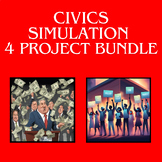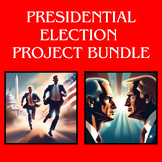Presidential Election Campaign Simulation Project: Win the Electoral College
- Zip
Also included in
- In the Civics Project Bundle, you will have access to four projects that place students in the shoes of a 21st century citizen as they explore contemporary issues from the last several decades. Included in this bundle are the following:1. Presidential Election Campaign Simulation Project2. LobbyingPrice $19.99Original Price $24.96Save $4.97
- In the Presidential Election Project Bundle: Campaign Simulation & WebQuest/Escape Room, students will have the opportunity to learn about the inner workings of Presidential Election campaigns from primaries to PAC's with the Presidential Election Campaign Simulation and will then apply this knoPrice $12.99Original Price $14.98Save $1.99
Description
In the US Presidential Election Campaign Simulation Project: Win the Electoral College, students will simulate US Presidential campaign events including candidate selection, primaries, town halls, fundraising through PAC's, advertising to voter demographics, and Presidential debates.
Race to the White House is a project that is designed to simulate and gamify a US Presidential Campaign. Students will form campaign teams and go through typical parts of the campaign such as selecting Presidential and Vice Presidential Candidates, participating in Primary Town Halls, seeking fundraising opportunities from PAC’s, building advertising campaigns to target voter demographics, and participating in a final Presidential Debate. At the core of every decision they make is the balancing act of appealing to the five voting blocs: Liberal Democrats, Moderate Democrats, Independents, Moderate Republicans, and Conservative Republicans. Each decision will increase or decrease their support with certain groups- all of which are backed by actual data from Pew Research to make the simulation as realistic as possible. The strategy of appealing to these voting blocs is further complicated by the simplified version of the Electoral College in which the teams will compete in four winner-take-all regions of America, each of which has a different combination of the five voting blocs to appeal to in that region.
The Campaign Report Cards presentation is a live Powerpoint/Google Slides that you can update daily to show the students where each candidates’ support stands. The Decision Results Answer Key is a cheat sheet for the teacher to reference as they calculate how each group's decisions play out. The Master Scorecard is a document the teacher can use to keep track of every decision that each team makes. The Electoral College document contains a description of the modified voting process, the electoral votes and voting blocs for each region, and four worksheets for each region. At the start of each day, each group will be able to request the worksheet from one region to learn more about the electorate and voting power in that region.
The project is divided into four “Phases”, each of which is built to work for a roughly 40-45 minute class period. In each phase, students will have a Phase Worksheet to complete, which comes with direction, an activity, and a hyperlinked background reading on the topic of the day. There are also Powerpoint/Google Slide Presentations associated with each day which contain information that the students will be using, such as candidate archetypes or town hall questions. These presentations can be displayed to the class or shared with the students electronically.
In Phase 1, the class will be learning about the candidate selection process. Students will be viewing several archetypes for both the Presidential and Vice Presidential Candidates. The Presidential Archetype will determine their starting support for each of the five voting blocs, while the VP Archetype will give an extra boost to one category. Students will then complete the Phase 1 Worksheet and write a short speech announcing their candidacy.
In Phase 2, the class will be learning about primaries and town halls. Students will be choosing one of five town halls to attend based on the subject they would like to answer questions about. They will be faced with three questions in the town hall and will record their responses on the Phase 2 Worksheet. Students may complete their own research to try to predict how their responses will go over with different voting blocs before completing the worksheet.
In Phase 3, the class will learn about fundraising and campaign advertising. Students will view offers from 8 different special interest groups and choose which one they will make a pledge to in exchange for funding. You can encourage them to research these organizations and consider the political ramifications before choosing one. Students will also choose from 6 different advertisements that will each target a different voting demographic. The group will not only choose which ad to run, but also which of the four regions to run the ad in. They will make their decisions final on the Phase 3 Worksheet.
In phase 4, the class will learn about presidential debates. The students will be given 8 potential questions that they must prepare to answer. One member of each group must stand in as the candidate for the debate and will have to answer two of the questions on the spot. The groups may also plan out an attack on one opposing candidate to strategically drain support from that candidate with a particular voting bloc. The groups will complete the Phase 4 Worksheet before the debate.
Once the debate has concluded, the teacher will calculate the results of the debate into their report cards. The teacher will then use the report cards to calculate the winner of each region for the Electoral College. While this is happening, the students will answer the Project Reflection Question. Once the teacher has finished calculating and the students have finished responding, the teacher will reveal the results of the election and the project will be complete!
*Newly added Team Strategy Sheets allows students to keep track of their polling data, as well as where they stand in relation to their opponents with different voting blocs. You may choose to share Report Cards daily and allow the groups to update these sheets.
If you enjoy this project, check out some of the other 21st Century Citizen Projects we offer at Living Through History!
Congressional Lobbying & Lawmaking Simulation Role Play Activity (teacherspayteachers.com)
2024 U.S. Presidential Election Escape Room WebQuest on Google Form (teacherspayteachers.com)
Crisis Response Simulation Natural Disaster, Market Crash, Pandemic (teacherspayteachers.com)
Evaluating Progress on Racial Equality and Social Justice WebQuest (teacherspayteachers.com)




